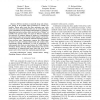Free Online Productivity Tools
i2Speak
i2Symbol
i2OCR
iTex2Img
iWeb2Print
iWeb2Shot
i2Type
iPdf2Split
iPdf2Merge
i2Bopomofo
i2Arabic
i2Style
i2Image
i2PDF
iLatex2Rtf
Sci2ools
ECBS
2011
IEEE
2011
IEEE
Finding Interaction Faults Adaptively Using Distance-Based Strategies
Abstract—Software systems are typically large and exhaustive testing of all possible input parameters is usually not feasible. Testers select tests that they anticipate may catch faults, yet many unanticipated faults may be overlooked. This work complements current testing methodologies by adaptively dispensing one-test-at-a-time, where each test is as “distant” as possible from previous tests. Two types of distance measures are explored: (1) distance defined in relation to combinations of parameter-values not previously tested together and (2) distance computed as the maximum minimal Hamming distance from previous tests. Experiments compare the effectiveness of these two types of distance-based tests and random tests. Experiments include simulations, as well as examination of instrumented data from an actual system, the Traffic Collision Avoidance System (TCAS). Results demonstrate that the two instantiations of distance-based tests often find more faults sooner and in fewer ...
Related Content
| Added | 19 Dec 2011 |
| Updated | 19 Dec 2011 |
| Type | Journal |
| Year | 2011 |
| Where | ECBS |
| Authors | Renée C. Bryce, Charles J. Colbourn, D. Richard Kuhn |
Comments (0)

